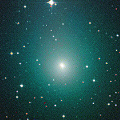
|
Now it is bright as 9.3 mag (Oct. 4, Carlos Labordena). It will be fading after this. In the Southern Hemisphere, it is observable in excellent condition after this. In the Northern Hemisphere, it will be unobservable in November.
Date(TT) R.A. (2000) Decl. Delta r Elong. m1 Best Time(A, h)
Oct. 26 21 50.30 -35 24.9 1.054 1.619 104 10.7 19:32 ( 0, 19)
Nov. 2 21 41.15 -38 38.0 1.253 1.664 94 11.3 18:56 ( 0, 16)
|
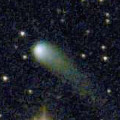
|
Now it is 12.9 mag (Oct. 2, Chris Wyatt). It is expected to brighten up to 8 mag in 2020. It stays observable in good condition for a long time in the Northern Hemisphere. In the Southern Hemisphere, it will be getting lower gradually, and it will be unobservable in early December.
Date(TT) R.A. (2000) Decl. Delta r Elong. m1 Best Time(A, h)
Oct. 26 5 38.49 33 32.4 2.218 2.914 125 11.1 3:24 ( 0, 88)
Nov. 2 5 35.42 35 41.1 2.078 2.848 132 10.9 2:53 (180, 89)
|

|
Now it is 11.6 mag (Oct. 4, Carlos Labordena). It stays bright as 11 mag until winter. It stays observable in good condition for a long time in the Northern Hemisphere. In the Southern Hemisphere, it locates low, and it will be unobservable in early December.
Date(TT) R.A. (2000) Decl. Delta r Elong. m1 Best Time(A, h)
Oct. 26 0 57.35 37 23.5 2.220 3.129 151 11.2 22:38 (180, 87)
Nov. 2 0 40.96 38 10.7 2.248 3.126 146 11.2 21:54 (180, 87)
|
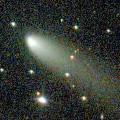
|
Now it is 11.7 mag (Oct. 5, Carlos Labordena). It stays 12 mag until November. It is observable in excellent condition in the Northern Hemisphere. It stays locating extremely low in the Southern Hemisphere.
Date(TT) R.A. (2000) Decl. Delta r Elong. m1 Best Time(A, h)
Oct. 26 2 43.66 48 32.4 0.592 1.507 142 12.0 0:30 (180, 76)
Nov. 2 2 37.81 49 41.2 0.614 1.535 144 12.2 23:52 (180, 75)
|

|
Now it is bright as 12.6 mag (Oct. 25, Toshihiko Ikemura, Hirohisa Sato).
Date(TT) R.A. (2000) Decl. Delta r Elong. m1 Best Time(A, h)
Oct. 26 0 33.79 14 39.6 4.838 5.777 159 13.1 22:16 ( 0, 70)
Nov. 2 0 31.17 14 19.7 4.882 5.778 152 13.2 21:45 ( 0, 69)
|
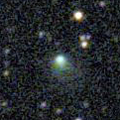
|
Now it is 13.9 mag (Oct. 26, Toshihiko Ikemura, Hirohisa Sato). It will be fading slowly after this.
Date(TT) R.A. (2000) Decl. Delta r Elong. m1 Best Time(A, h)
Oct. 26 19 16.77 -15 47.3 1.747 1.800 76 13.8 18:37 ( 29, 34)
Nov. 2 19 34.17 -15 58.6 1.799 1.795 73 13.8 18:31 ( 29, 34)
|

|
It has not been observed yet in this apparition. Now it is fainter than 21.5 mag (Aug. 4, Erwin Schwab). It was expected to brighten up to 12 mag from August to September. But actually, it must be much fainter than expected. It is observable in good condition in the Northern Hemisphere. It is not observable in the Southern Hemisphere.
Date(TT) R.A. (2000) Decl. Delta r Elong. m1 Best Time(A, h)
Oct. 26 7 21.91 54 53.5 1.072 1.643 105 14.1 4:50 (187, 70)
Nov. 2 7 31.21 56 27.1 1.070 1.686 109 14.5 4:49 (180, 69)
|

|
Now it is 14.3 mag (Oct. 18, Chris Wyatt). It stays 13-14 mag for a long time in 2019. In the Southern Hemisphere, it is observable in good condition. In the Northern Hemisphere, it is not observasble until summer in 2020.
Date(TT) R.A. (2000) Decl. Delta r Elong. m1 Best Time(A, h)
Oct. 26 17 10.00 -85 35.9 3.263 3.154 74 14.3 18:37 ( 4,-32)
Nov. 2 19 3.22 -83 26.2 3.312 3.172 73 14.3 18:31 ( 4,-29)
|

|
Now it is 14.7 mag (Sept. 6, Ken-ichi Kadota). It is observable at 14 mag in good condition in autumn.
Date(TT) R.A. (2000) Decl. Delta r Elong. m1 Best Time(A, h)
Oct. 26 9 11.43 9 53.5 2.652 2.577 74 14.5 4:50 (303, 52)
Nov. 2 9 18.52 9 6.1 2.593 2.608 79 14.6 4:55 (313, 55)
|

|
It brightened up to 7.7 mag in June in 2018 (June 19, Juan Jose Gonzalez). Now it is fading. It has already faded down to 14.2 mag (Sept. 10, Thomas Lehmann). In the Southern Hemisphere, it stays observable for a long time until the comet will fade out. In the Northern Hemisphere, it is appearing in the morning sky, but it stays low for a while.
Date(TT) R.A. (2000) Decl. Delta r Elong. m1 Best Time(A, h)
Oct. 26 6 58.59 -33 24.2 4.889 5.084 95 14.7 4:43 ( 0, 22)
Nov. 2 6 55.05 -33 50.2 4.875 5.140 99 14.7 4:12 ( 0, 21)
|

|
Now it is 14.6 mag (Oct. 18, Chris Wyatt). In the Southern Hemisphere, it is observable for a long time. It stays low in the Northern Hemisphere.
Date(TT) R.A. (2000) Decl. Delta r Elong. m1 Best Time(A, h)
Oct. 26 22 56.62 -38 18.9 4.040 4.535 113 14.9 20:39 ( 0, 17)
Nov. 2 22 54.05 -36 55.8 4.154 4.565 108 15.0 20:09 ( 0, 18)
|

|
Now it is 15.5-16.0 mag (Oct. 22, Hirofumi Koremasa). It will brighten very rapidly, and it will brighten up to 14 mag in winter. It is observable in excellent condition in the Northern Hemisphere. It locates low in the Southern Hemisphere.
Date(TT) R.A. (2000) Decl. Delta r Elong. m1 Best Time(A, h)
Oct. 26 2 21.07 46 59.2 0.863 1.771 144 15.6 0:07 (180, 78)
Nov. 2 2 18.05 46 18.9 0.818 1.741 148 15.4 23:32 (180, 79)
|
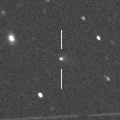
|
Now it is 15.3 mag (Oct. 25, Toshihiko Ikemura, Hirohisa Sato). It stays 15.5 mag until December, and it is observable in good condition.
Date(TT) R.A. (2000) Decl. Delta r Elong. m1 Best Time(A, h)
Oct. 26 23 42.95 -9 49.4 1.597 2.441 139 15.7 21:25 ( 0, 45)
Nov. 2 23 42.78 -9 41.0 1.639 2.425 132 15.7 20:57 ( 0, 45)
|

|
It brightened rapidly, and brightened up to 10.8 mag in summer (Aug. 25, Thomas Lehmann). Now it is fading. But it is still bright as 13.6 mag (Sept. 26, iTelescope Observatory, Siding Spring). In the Southern Hemisphere, it stays observable in the low sky until it becomes fainter than 18 mag in winter. It is not observable at all in the Northern Hemisphere.
Date(TT) R.A. (2000) Decl. Delta r Elong. m1 Best Time(A, h)
Oct. 26 14 28.53 -62 25.3 2.371 1.900 50 15.7 18:37 ( 33,-33)
Nov. 2 15 10.55 -61 57.4 2.480 1.962 48 16.2 18:31 ( 33,-31)
|
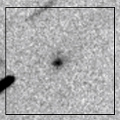
|
Now it is 16.4 mag (Oct. 4, Toshihiko Ikemura, Hirohisa Sato). The orbit is extremely hyperbolic with e=3.35. It is the first interstellar comet in history. It brightens up to 15 mag in December. In the Northern Hemisphere, it stays observable in good condition until early December. Then it will be getting lower, and it will be unobservable in mid January. In the Southern Hemisphere, it is not observable for a while. But it will appear in the morning sky in late October, then it will be observable in excellent condition.
Date(TT) R.A. (2000) Decl. Delta r Elong. m1 Best Time(A, h)
Oct. 26 10 12.24 11 16.9 2.531 2.227 61 16.0 4:50 (287, 41)
Nov. 2 10 24.85 7 15.5 2.412 2.164 63 15.8 4:55 (296, 43)
|
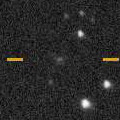
|
Now it is 15.0 mag (July 21, Taras Prystavski). It stays 16 mag for a long time from 2019 to 2020. It stays observable for a long time in the Southern Hemisphere. It is hardly observable in the Northern Hemisphere.
Date(TT) R.A. (2000) Decl. Delta r Elong. m1 Best Time(A, h)
Oct. 26 12 20.92 -69 23.0 3.859 3.459 59 15.8 4:50 (337,-29)
Nov. 2 12 32.79 -71 38.7 3.847 3.453 59 15.8 4:55 (340,-28)
|
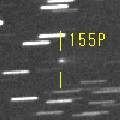
|
Now it is 16.7 mag (Oct. 9, Toshihiko Ikemura, Hirohisa Sato). It brightens rapidly, and it will be observable at 15 mag in good condition in winter. It locates somewhat low in the Southern Hemisphere.
Date(TT) R.A. (2000) Decl. Delta r Elong. m1 Best Time(A, h)
Oct. 26 9 4.55 17 11.9 1.730 1.815 78 16.1 4:50 (296, 58)
Nov. 2 9 21.50 16 25.2 1.667 1.808 81 15.9 4:55 (302, 60)
|

|
Now it is 16.0 mag (Sept. 8, Roberto Haver). It is observable at 16 mag in good condition from October to November.
Date(TT) R.A. (2000) Decl. Delta r Elong. m1 Best Time(A, h)
Oct. 26 4 16.60 10 49.7 1.623 2.512 146 16.1 2:03 ( 0, 66)
Nov. 2 3 48.07 7 49.7 1.582 2.534 158 16.0 1:07 ( 0, 63)
|

|
Now it is 16.0 mag (Oct. 4, Toshihiko Ikemura, Hirohisa Sato). It is observable at 16 mag in good condition from summer to autumn. It locates somewhat low in the Southern Hemisphere.
Date(TT) R.A. (2000) Decl. Delta r Elong. m1 Best Time(A, h)
Oct. 26 3 40.95 29 6.1 1.324 2.246 150 16.2 1:27 ( 0, 84)
Nov. 2 3 35.75 28 47.1 1.317 2.269 158 16.4 0:54 ( 0, 84)
|

|
Now it is 15.8 mag (Oct. 5, Toshihiko Ikemura, Hirohisa Sato). It stays 15-16 mag for a long time until 2021.
Date(TT) R.A. (2000) Decl. Delta r Elong. m1 Best Time(A, h)
Oct. 26 20 2.35 -25 53.1 4.839 4.861 85 16.3 18:37 ( 13, 28)
Nov. 2 20 1.42 -24 56.3 4.940 4.839 78 16.3 18:31 ( 19, 28)
|
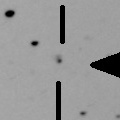
|
It looks cometary on the LCO (CTIO) image on Aug. 21. Now it is 16.2 mag (Oct. 2, ATLAS-MLO, Mauna Loa). It is observable in excellent condition in the Southern Hemisphere. In the Northern Hemisphere, it locates extremely low for a while.
Date(TT) R.A. (2000) Decl. Delta r Elong. m1 Best Time(A, h)
Oct. 26 19 48.29 -38 53.5 6.517 6.425 80 16.3 18:37 ( 13, 15)
Nov. 2 19 46.69 -38 17.7 6.640 6.427 73 16.4 18:31 ( 18, 14)
|
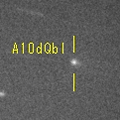
|
Now it is 15.9 mag (Oct. 2, Alexander Baransky). It stays observable in good condition while the comet will be fading slowly after this.
Date(TT) R.A. (2000) Decl. Delta r Elong. m1 Best Time(A, h)
Oct. 26 3 29.19 0 30.9 1.575 2.511 154 16.4 1:15 ( 0, 56)
Nov. 2 3 25.85 -0 21.3 1.606 2.558 159 16.5 0:44 ( 0, 55)
|

|
Now it is 16.2 mag (Oct. 4, Toshihiko Ikemura, Hirohisa Sato). It is expected to be observable at 5-6 mag for a long time from 2022 to 2023. In the Northern Hemisphere, it is not observable at the high light from 2022 summer to 2023 summer. In the Southern Hemisphere, it stays unobservable for a while. But it will be observable in good condition at the high light.
Date(TT) R.A. (2000) Decl. Delta r Elong. m1 Best Time(A, h)
Oct. 26 17 16.09 48 28.6 10.802 10.581 74 16.4 18:37 (126, 48)
Nov. 2 17 18.85 47 54.9 10.776 10.533 73 16.4 18:31 (125, 45)
|
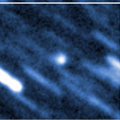
|
Now it is 15.1 mag (Oct. 5, Toshihiko Ikemura, Hirohisa Sato). It is brighter than this ephemeris recently. It stays at 15-16 mag until December. It is observable in good condition in the Southern Hemisphere. It locates somewhat low in the Northern Hemisphere.
Date(TT) R.A. (2000) Decl. Delta r Elong. m1 Best Time(A, h)
Oct. 26 19 47.70 -22 58.4 1.658 1.821 82 16.4 18:37 ( 18, 30)
Nov. 2 20 1.84 -21 16.0 1.711 1.810 79 16.4 18:31 ( 20, 31)
|
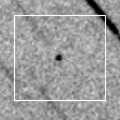
|
Now it is 16.7 mag (Aug. 9. Grorudalen Optical Observatory). It passed the perihelion on July 2. Then it must have brightened up to 13 mag, but it was not observable around that time. In the Northern Hemisphere, it stays observable in excellent condition until December when it becomes fainter than 18 mag. In the Southern Hemisphere, it stays locating low.
Date(TT) R.A. (2000) Decl. Delta r Elong. m1 Best Time(A, h)
Oct. 26 1 15.69 46 50.7 0.976 1.874 144 16.5 22:56 (180, 78)
Nov. 2 0 54.06 43 10.8 1.027 1.927 145 16.7 22:07 (180, 82)
|

|
Now it is 16.7 mag (Oct. 4, Toshihiko Ikemura, Hirohisa Sato). It will brighten up to 10.5 mag from 2020 December to 2021 January. In the Northern Hemisphere, it stays observable in good condition while the comet will be brightening gradually, but it is not observable at the high light. In the Southern Hemisphere, it is not observable for a long time, but it will be observable in good condition after the high light.
Date(TT) R.A. (2000) Decl. Delta r Elong. m1 Best Time(A, h)
Oct. 26 16 36.61 67 16.4 4.858 4.862 84 16.8 18:37 (152, 42)
Nov. 2 16 42.90 66 2.2 4.793 4.800 84 16.7 18:31 (150, 40)
|

|
It will brighten up to 13.5-14 mag from 2020 to 2021. It stays observable in good condition for a long time after this until 2020 summer.
Date(TT) R.A. (2000) Decl. Delta r Elong. m1 Best Time(A, h)
Oct. 26 11 55.12 15 7.1 4.416 3.725 41 17.0 4:50 (267, 23)
Nov. 2 12 3.10 14 30.1 4.330 3.707 45 16.9 4:55 (271, 28)
|
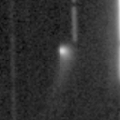
|
Now it is 17.2 mag (Oct. 5, Toshihiko Ikemura, Hirohisa Sato). It will be fading after this. In the Northern Hemisphere, it stays observable in good condition for a long time. In the Southern Hemisphere, it stays extremely low for a long time.
Date(TT) R.A. (2000) Decl. Delta r Elong. m1 Best Time(A, h)
Oct. 26 2 19.55 45 27.1 3.347 4.211 146 16.9 0:06 (180, 79)
Nov. 2 2 4.63 43 44.5 3.359 4.250 150 16.9 23:18 (180, 81)
|

|
Fading. Now it is 16.8 mag (Oct. 9, Toshihiko Ikemura, Hirohisa Sato). It stays 17 mag from autumn to winter. It is observable in good condition in the Northern Hemisphere. It locates low in the Southern Hemisphere.
Date(TT) R.A. (2000) Decl. Delta r Elong. m1 Best Time(A, h)
Oct. 26 9 20.27 24 0.7 6.505 6.358 77 16.9 4:50 (281, 59)
Nov. 2 9 19.23 23 52.2 6.425 6.401 84 16.9 4:55 (290, 65)
|

|
It stays 16-17 mag for a long time until 2020. It is observable in good condition in the Northern Hemisphere. It is hardly observable in the Southern Hemisphere.
Date(TT) R.A. (2000) Decl. Delta r Elong. m1 Best Time(A, h)
Oct. 26 12 47.88 52 10.2 8.918 8.565 66 16.9 4:50 (225, 29)
Nov. 2 12 53.33 51 57.1 8.870 8.572 69 16.9 4:55 (226, 33)
|

|
Fading now. Now it is 16.1 mag (Sept. 23, iTelescope Observatory, Siding Spring). In the Southern Hemisphere, it stays observable for a long time until it fades out. In the Northern Hemisphere, it will not be observable after this.
Date(TT) R.A. (2000) Decl. Delta r Elong. m1 Best Time(A, h)
Oct. 26 6 30.76 -48 10.5 5.055 5.237 95 17.1 4:15 ( 0, 7)
Nov. 2 6 24.32 -49 46.5 5.071 5.289 97 17.2 3:41 ( 0, 5)
|
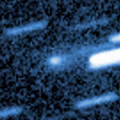
|
First return of a new periodic comet which brightened up to 16.5 mag in 2009. Now it is 16.2 mag (Sept. 11, Ken-ichi Kadota). It stays 16.5 mag until October. It is observable in good condition in the Northern Hemisphere. It locates low in the Southern Hemisphere.
Date(TT) R.A. (2000) Decl. Delta r Elong. m1 Best Time(A, h)
Oct. 26 9 41.24 10 1.9 1.459 1.422 67 17.1 4:50 (296, 47)
Nov. 2 9 56.53 7 50.5 1.456 1.464 70 17.3 4:55 (302, 48)
|
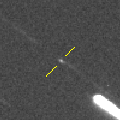
|
First return of a new periodic comet which brightened up to 18 mag in 2014. Now it is 17.3 mag (Oct. 5, Toshihiko Ikemura, Hirohisa Sato). It stays 17 mag until November. It is observable in good condition in the Northern Hemisphere. It locates extremely low in the Southern Hemisphere.
Date(TT) R.A. (2000) Decl. Delta r Elong. m1 Best Time(A, h)
Oct. 26 7 13.60 43 4.1 0.327 1.132 106 17.1 4:50 (191, 82)
Nov. 2 7 37.06 43 31.3 0.343 1.150 108 17.2 4:54 (180, 82)
|

|
Now it is 18.9 mag (Oct. 3, Observatoire Chante-Perdrix, Dauban). It will approaches to Earth down to 0.09 a.u. in early January. It will be obesrvable in excellent condition in the Northern Hemisphere. If it is as bright as in 2003, it will be 17.5 mag at best. But actually, it is brighter recently than in 2003. If it shows cometary activity, it may brighten up to 13.5 mag. In the Southern Hemisphere, it will not be observable at the high light.
Date(TT) R.A. (2000) Decl. Delta r Elong. m1 Best Time(A, h)
Oct. 26 22 30.00 -24 51.2 0.415 1.239 116 17.7 20:12 ( 0, 30)
Nov. 2 22 24.60 -24 11.8 0.392 1.182 109 17.4 19:39 ( 0, 31)
|
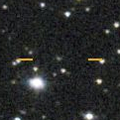
|
Now it is 17.4 mag (Oct. 4, Toshihiko Ikemura, Hirohisa Sato). It will stay at 14 mag for a long time from 2021 to 2022. In the Northern Hemisphere, it stays observable in good condition while brightening gradually, although it becomes low in December and January. In the Southern Hemisphere, it locates extremely low now, and it will be unobservable soon.
Date(TT) R.A. (2000) Decl. Delta r Elong. m1 Best Time(A, h)
Oct. 26 18 22.94 37 29.7 7.522 7.400 79 17.4 18:37 (106, 59)
Nov. 2 18 24.35 36 26.8 7.546 7.364 75 17.4 18:31 (105, 55)
|

|
Now it is 16.1 mag (Oct. 1, Alexander Baransky). It will be fading after this, and it will be fainter than 18 mag in November.
Date(TT) R.A. (2000) Decl. Delta r Elong. m1 Best Time(A, h)
Oct. 26 23 7.65 -16 25.1 1.964 2.701 128 17.5 20:49 ( 0, 38)
Nov. 2 23 1.83 -19 5.7 2.116 2.744 119 17.7 20:16 ( 0, 36)
|

|
Now it is 17.6 mag (Sept. 26, Toshihiko Ikemura, Hirohisa Sato). It will brighten up to 12 mag in winter in 2022.
Date(TT) R.A. (2000) Decl. Delta r Elong. m1 Best Time(A, h)
Oct. 26 22 2.78 45 14.1 7.028 7.577 120 17.5 19:45 (180, 80)
Nov. 2 22 1.77 44 40.7 7.029 7.531 117 17.5 19:16 (180, 80)
|

|
It approached to Earth down to 0.3 a.u. in mid February, and brightened up to 5.5 mag (Feb. 13, Juan Jose Gonzalez). Now it is fading. It has already faded down to 17.9 mag (Oct. 5, Toshihiko Ikemura, Hirohisa Sato).
Date(TT) R.A. (2000) Decl. Delta r Elong. m1 Best Time(A, h)
Oct. 26 2 12.62 40 34.3 2.716 3.620 151 17.6 23:53 (180, 84)
Nov. 2 1 55.20 39 4.0 2.771 3.691 154 17.7 23:08 (180, 86)
|
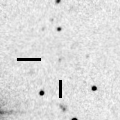
|
Now it is 17.9 mag (Oct. 8, ATLAS-MLO, Mauna Loa). It is observable at 17-18 mag for a long time from late 2019 to early 2021. It will fade out before it passes the perihelion.
Date(TT) R.A. (2000) Decl. Delta r Elong. m1 Best Time(A, h)
Oct. 26 3 21.36 1 8.3 4.285 5.214 156 17.6 1:07 ( 0, 56)
Nov. 2 3 17.93 0 55.5 4.251 5.201 161 17.6 0:36 ( 0, 56)
|

|
Now it is 18.8 mag (Sept. 27, M. Jaeger, E. Prosperi, S. Prosperi). It is fainter than this ephemeris recently.
Date(TT) R.A. (2000) Decl. Delta r Elong. m1 Best Time(A, h)
Oct. 26 2 35.65 10 2.2 3.209 4.194 170 17.6 0:22 ( 0, 65)
Nov. 2 2 30.86 9 47.6 3.218 4.207 175 17.6 23:45 ( 0, 65)
|
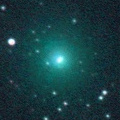
|
It brightened up to 11 mag in late 2018. Now it is 17.9 mag (Oct. 5, Toshihiko Ikemura, Hirohisa Sato). It will be fainter than 18 mag in November. It is observable in excellent condition in the Northern Hemisphere. It locates extremely low in the Southern Hemisphere.
Date(TT) R.A. (2000) Decl. Delta r Elong. m1 Best Time(A, h)
Oct. 26 3 22.81 46 32.5 3.343 4.167 141 17.6 1:09 (180, 78)
Nov. 2 3 14.57 45 30.7 3.360 4.230 147 17.8 0:33 (180, 79)
|

|
Now it is 18.0 mag (Oct. 9, Toshihiko Ikemura, Hirohisa Sato). It was exptected to brighten up to 16.5 mag from October to December. But actually, it is fainter than originally expected. It seems to brighten up to 18 mag at best. It is observable in good condition in the Northern Hemisphere. It locates low in the Southern Hemisphere.
Date(TT) R.A. (2000) Decl. Delta r Elong. m1 Best Time(A, h)
Oct. 26 8 18.45 19 35.7 1.266 1.605 89 18.0 4:50 (309, 68)
Nov. 2 8 35.70 21 31.1 1.209 1.606 93 17.9 4:55 (313, 71)
|
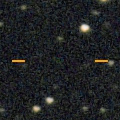
|
Now it is very faint as 19.7 mag (Oct. 25, Toshihiko Ikemura, Hirohisa Sato). It brightened up to 15.5 mag in 1997, and 17 mag in 2008, however, it is much fainter in this apparition.
Date(TT) R.A. (2000) Decl. Delta r Elong. m1 Best Time(A, h)
Oct. 26 1 15.06 16 55.4 2.353 3.333 168 20.1 22:57 ( 0, 72)
Nov. 2 1 11.68 16 8.0 2.381 3.339 161 20.1 22:26 ( 0, 71)
|
|
![]()
 C/2018 A6 ( Gibbs )
C/2018 A6 ( Gibbs ) 78P/Gehrels 2
78P/Gehrels 2 C/2016 M1 ( PanSTARRS )
C/2016 M1 ( PanSTARRS ) C/2017 B3 ( LINEAR )
C/2017 B3 ( LINEAR ) 114P/Wiseman-Skiff
114P/Wiseman-Skiff 101P/Chernykh
101P/Chernykh C/2019 A9 ( PanSTARRS )
C/2019 A9 ( PanSTARRS ) 2I/2019 Q4 ( Borisov )
2I/2019 Q4 ( Borisov ) C/2018 F4 ( PanSTARRS )
C/2018 F4 ( PanSTARRS ) 155P/Shoemaker 3
155P/Shoemaker 3 C/2018 DO4 ( Lemmon )
C/2018 DO4 ( Lemmon ) 261P/Larson
261P/Larson C/2019 K7 ( Smith )
C/2019 K7 ( Smith ) A/2017 U7
A/2017 U7 C/2019 K5 ( Young )
C/2019 K5 ( Young ) C/2017 K2 ( PanSTARRS )
C/2017 K2 ( PanSTARRS ) 160P/LINEAR
160P/LINEAR (3200) Phaethon
(3200) Phaethon C/2019 N1 ( ATLAS )
C/2019 N1 ( ATLAS ) 246P/NEAT
246P/NEAT C/2018 A3 ( ATLAS )
C/2018 A3 ( ATLAS ) C/2015 O1 ( PanSTARRS )
C/2015 O1 ( PanSTARRS ) C/2010 U3 ( Boattini )
C/2010 U3 ( Boattini ) C/2016 N6 ( PanSTARRS )
C/2016 N6 ( PanSTARRS ) 387P/2019 R1 ( Boattini )
387P/2019 R1 ( Boattini ) 384P/2019 O1 ( Kowalski )
384P/2019 O1 ( Kowalski ) 289P/Blanpain
289P/Blanpain C/2018 U1 ( Lemmon )
C/2018 U1 ( Lemmon ) C/2019 K4 ( Ye )
C/2019 K4 ( Ye ) C/2019 L3 ( ATLAS )
C/2019 L3 ( ATLAS ) C/2018 Y1 ( Iwamoto )
C/2018 Y1 ( Iwamoto ) 173P/Mueller 5
173P/Mueller 5 65P/Gunn
65P/Gunn C/2018 L2 ( ATLAS )
C/2018 L2 ( ATLAS ) 76P/West-Kohoutek-Ikemura
76P/West-Kohoutek-Ikemura 200P/Larsen
200P/Larsen![]()







































